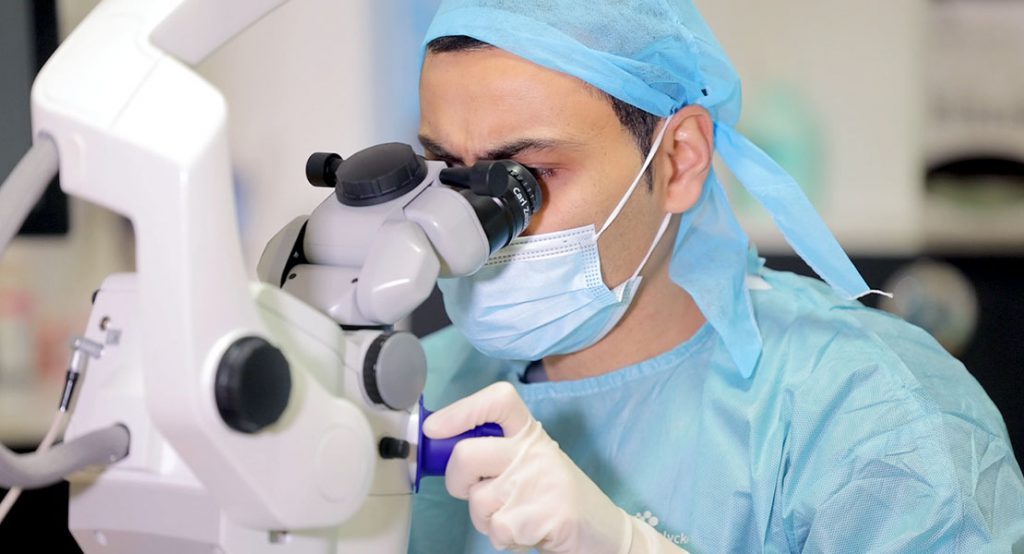Let’s be honest—cataracts are one of those things most people associate with “getting older”, but not many of us actually know what they are or why they happen. You might have heard the term during an optician’s visit or from an older relative, but when you hear that someone has a “cloudy lens”, it sounds more poetic than scientific, doesn’t it?
In this article, we’re going to clear up that cloud—literally and figuratively. We’ll unpack the actual science behind how cataracts form, why your lens goes from clear to cloudy, and what’s really going on inside your eye. And we’re going to do this without throwing you into a sea of medical jargon. So, if you’ve ever wondered what causes cataracts or how to prevent them, you’re in exactly the right place.
Understanding the Eye Lens: A Quick Refresher
To understand cataract formation, you first need a grasp of what the lens actually is and what it’s supposed to do. Think of your eye like a camera. The lens sits just behind the coloured part of your eye (the iris) and its job is to focus light onto the retina at the back of your eye. The retina then sends visual signals to your brain, and that’s how you see.
Now here’s the key point: your lens is meant to be crystal clear. This transparency is what allows light to pass through unobstructed. It’s made primarily of water and proteins that are organised in such a precise way that light can travel through easily.
So when that clarity disappears—when the lens starts looking cloudy or milky—that’s a cataract. But what causes that change? That’s where the real story begins.
What Is a Cataract, Exactly?
A cataract is a clouding of the eye’s natural lens. It doesn’t happen overnight; it’s usually a slow process. You won’t just wake up one day and find your vision suddenly blurred, but over months or years, you may notice things like glare from lights, duller colours, or difficulty seeing clearly, especially at night.
The cloudiness comes from a breakdown of the proteins within the lens. Over time, these proteins clump together and scatter light, preventing it from focusing sharply on the retina. That’s why your vision becomes blurred or dim.
But here’s the thing: this clumping isn’t random. It’s triggered by a range of biological and environmental factors—and that’s what we’re diving into next.
The Protein Puzzle: Why Clarity Turns to Cloudiness
Let’s talk proteins. Your lens is made up of specialised proteins called crystallins. These are no ordinary proteins—they’re designed to stay stable and clear for decades. That’s pretty impressive when you think about it.
But with age and exposure to damaging elements, these proteins start to unravel, misfold, and clump together. When this happens, the orderly structure breaks down. Instead of a smooth, transparent lens, you start getting protein clumps that scatter light.

So what causes this misfolding? There are a few key culprits:
- Oxidative stress
- UV light exposure
- High blood sugar
- Genetic changes
- Medications and toxins
Let’s look at each of these in more depth.
Oxidative Stress: The Invisible Enemy
Oxidative stress plays a central role in the breakdown of lens clarity, and it’s something that’s happening in your body right now—whether you’re aware of it or not. Every time your cells generate energy, they also produce reactive oxygen species (ROS). These unstable molecules are byproducts of normal metabolism, but when their levels rise too high, they begin to cause damage. It’s a bit like running an engine that gradually rusts itself over time—efficient, but not without a price.
In your eyes, these free radicals target the delicate proteins and lipids that make up the lens. Crystallins—the structural proteins responsible for keeping the lens transparent—are particularly vulnerable. When these proteins are attacked by free radicals, their shape and structure are altered. This makes them prone to sticking together, which forms clumps that scatter incoming light. The lens begins to look hazy or yellowed, and that’s when you start noticing the tell-tale signs of a cataract.
What’s concerning is that oxidative stress doesn’t need to come from internal processes alone. External factors like smoking, pollution, and a poor diet lacking in antioxidant-rich foods can dramatically speed up the damage. Even certain infections and chronic inflammation in the body can tip the balance, making it harder for the body’s natural defence systems to keep things under control. When oxidative stress outpaces your body’s ability to neutralise it, your lens proteins bear the brunt of the damage.
But there’s a silver lining. While you can’t eliminate oxidative stress entirely, you can certainly reduce its impact. Eating foods high in antioxidants—like blueberries, spinach, and nuts—can help neutralise free radicals. Getting regular exercise, cutting back on alcohol, and quitting smoking also strengthen your body’s ability to defend itself. It’s about making daily choices that reduce the pressure on your eyes over the long term.
UV Light Exposure: Sunlight Isn’t Always Friendly
When you step outside on a sunny day, you might feel energised and refreshed, but your eyes are getting a very different experience—especially if you’re not wearing proper protection. Ultraviolet (UV) light from the sun penetrates your eye and reaches the lens, where it causes chemical reactions that can damage lens cells over time. Unlike sunburnt skin, though, you won’t feel this damage happening—it’s entirely silent and cumulative.
The proteins and fibres in the lens are not designed to repair themselves easily once damaged by UV rays. Prolonged exposure leads to denaturation of proteins and the formation of pigment granules that cause discolouration and opacification. Over time, the lens gradually becomes less transparent, making it harder for light to pass through and focus clearly. This effect is particularly noticeable with nuclear cataracts, which often develop in the centre of the lens as a result of chronic sun exposure.

Outdoor workers, athletes, and even frequent holiday-goers are often at increased risk of UV-related cataracts, especially if they spend hours outside without eye protection. Snow, water, and sand can reflect sunlight, intensifying UV exposure. So even on a cloudy day, UV radiation is still present and can still reach your eyes. It’s a cumulative threat, and like oxidative stress, the damage builds quietly over time until it begins to affect your sight.
Protecting your eyes doesn’t have to be complicated. Wearing sunglasses that block 100% of UVA and UVB rays is a simple yet powerful step. Adding a wide-brimmed hat offers even more coverage. Many people overlook UV protection until it’s too late, but starting early—even in childhood—can go a long way in preserving clear vision. It’s one of the easiest cataract risk factors to control, and the benefits last a lifetime.
High Blood Sugar: The Diabetes-Cataract Link
Living with diabetes means keeping an eye on many things—blood sugar levels, diet, medication—but many people don’t realise how closely connected their eye health is to their glucose control. When blood sugar remains consistently high, it doesn’t just affect the heart, kidneys, or nerves; it also impacts the lens of your eye. And unlike other parts of the body, the lens doesn’t have a direct blood supply, which makes it vulnerable in a very different way.
What happens is this: high levels of glucose in the aqueous humour—the fluid that nourishes the lens—get absorbed into the lens itself. Inside the lens, the glucose is converted into sorbitol, a sugar alcohol that isn’t easily metabolised or removed. Sorbitol attracts water into the lens, causing it to swell and distorting its architecture. Over time, this constant swelling and shrinking disrupts the organised structure of the lens fibres, leading to cloudiness.
The longer this cycle continues, the more damage it causes. Eventually, the proteins in the lens start to break down and clump together—similar to what happens with oxidative stress. But in this case, it’s the metabolic imbalance driving the deterioration. That’s why people with diabetes tend to develop cataracts earlier and more rapidly than those without the condition. It’s a physiological chain reaction that begins with a single, manageable variable—glucose.
Controlling your blood sugar is not only essential for your overall wellbeing, but it’s also one of the most effective ways to protect your eyes. Regular eye exams are particularly important if you have diabetes, as they can catch cataracts (and other diabetic eye conditions) before they start to seriously interfere with your vision. Being proactive about your eye health is key, especially when there’s a known risk factor like high blood sugar in play.
Genetic Predisposition: When It’s In Your DNA
Sometimes, despite your best efforts—eating well, staying active, protecting your eyes from UV—you still end up facing cataracts earlier than expected. That’s where genetics comes in. While it’s not the sole cause, your DNA can play a significant role in how likely you are to develop cataracts and when. Certain gene mutations affect how well your body can maintain the transparency and structure of the lens over time.
Some people inherit variations in genes that control antioxidant levels or repair damaged proteins. If these processes aren’t working efficiently from the start, it means the lens is more vulnerable to cumulative damage—even from everyday sources like light exposure or oxidative stress. It’s not about a single “cataract gene” but rather a combination of genetic traits that influence how resilient your lens is over time.
In rare cases, cataracts are present at birth—what we call congenital cataracts. These usually stem from more specific genetic mutations that disrupt how the lens develops in the womb. But even in adulthood, genetic predisposition still plays a part. If there’s a strong family history of early-onset cataracts, there’s a higher chance you might experience them too, especially when other risk factors are present.

That said, genes aren’t destiny. They set the stage, but your lifestyle still directs the play. Knowing you’re at higher risk can actually be empowering—it gives you the chance to take preventative steps earlier, get more frequent eye checks, and make smarter lifestyle choices. Genetics may nudge you in a certain direction, but how far you go is often still within your control.
Medications and Environmental Toxins
Not all causes of cataracts are internal. Some are introduced from the outside—often in the form of medications or environmental exposures that quietly interfere with the lens over time. One of the most common examples is corticosteroids. These drugs are essential for treating many health conditions, from autoimmune disorders to asthma, but long-term use can come at a price, especially for your eyes.
Steroids can disrupt the normal balance of proteins within the lens. Over time, they can alter the permeability of lens cell membranes and lead to changes in water balance, enzyme activity, and protein structure. This disturbance can encourage the aggregation of lens proteins, which then results in the opacities typical of steroid-induced cataracts. The posterior subcapsular region of the lens is particularly susceptible to these changes, often causing quicker declines in vision compared to age-related types.
Environmental toxins add another layer of risk. Prolonged exposure to certain industrial chemicals—such as naphthalene, heavy metals, or organic solvents—can damage the cellular components of the lens. People working in manufacturing, chemical processing, or agriculture may be at increased risk, especially if protective equipment isn’t used consistently. Repeated exposure to even low levels of toxins can have a cumulative effect, which means the damage may not appear until years later.
Being aware of these potential risks doesn’t mean avoiding necessary medications or abandoning your career, but it does mean being proactive. Always discuss long-term side effects with your doctor, especially when prescribed steroids. And if you work in an environment with hazardous substances, make eye protection a priority. A bit of precaution now can save your vision later.
Ageing: The Inevitable Factor
There’s no sugar-coating it—ageing is the one cataract risk factor we all share, and there’s no getting around it. As we get older, the lens simply loses its ability to maintain its original structure. The proteins within it become less soluble, and the cellular machinery responsible for maintaining transparency starts to wear out. It’s not so much a single event, but rather a slow decline in biological housekeeping.
The eye’s natural antioxidant defences also weaken over time. Glutathione, a powerful antioxidant in the lens, declines with age. This makes the lens more vulnerable to oxidative damage, UV radiation, and environmental stressors. The repair mechanisms that used to clean up misfolded proteins and prevent clumping become less efficient. Over decades, this steady decline accumulates until vision begins to blur and dim.
But ageing doesn’t affect everyone equally. Two people of the same age might have very different lens health depending on their lifestyle, diet, and exposure to environmental stress. That’s why some people only get mild cataracts in their 80s, while others may need surgery in their 50s. Age is a background risk—but how fast that risk turns into reality depends on your habits over a lifetime.

The good news is that age-related cataracts are often the most treatable. With regular eye exams, early detection, and lifestyle adjustments, many people delay cataract development significantly. And even when surgery becomes necessary, the procedure is safe and highly effective. So, while we can’t stop the clock, we can make the ticking feel a lot slower for our eyes.
Are All Cataracts the Same?
Actually, no. Cataracts come in different forms, depending on which part of the lens is affected:
- Nuclear Sclerotic Cataracts: These form in the central zone (nucleus) of the lens. They tend to develop slowly and are associated with ageing.
- Cortical Cataracts: These start on the outer edges of the lens and move inward, forming white, wedge-shaped opacities.
- Posterior Subcapsular Cataracts: These occur at the back of the lens, just in front of the capsule that holds the lens in place. They tend to progress more quickly and can affect near vision more than distance vision.
Each type may cause slightly different visual symptoms and can affect your vision in unique ways. This is why it’s so important to have a proper eye examination before making any assumptions.
Can Cataracts Be Prevented?
Here’s the million-pound question: can you stop cataracts before they start? While there’s no guaranteed way to prevent them entirely, there’s a lot you can do to delay their onset:
- Wear UV-protective sunglasses
- Eat a diet rich in antioxidants (think leafy greens, berries, and nuts)
- Avoid smoking
- Manage chronic conditions like diabetes
- Minimise exposure to environmental toxins
- Use protective eyewear in hazardous work environments
These may sound like common-sense health tips—and they are. But they also directly influence the health of your lens and how long it stays clear.
Why Cataract Surgery Is the Go-To Solution
Once cataracts reach a point where they seriously affect your vision, the only effective treatment is surgery. But don’t let the idea scare you—it’s one of the most commonly performed and successful procedures in the world.

The cloudy lens is removed and replaced with a clear artificial one, known as an intraocular lens (IOL). The surgery usually takes less than 30 minutes and has a very high success rate.
But here’s a bit of advice: don’t wait until your vision is severely impaired. Many people delay surgery far longer than necessary, thinking they can ‘cope’—but clearer vision is often just a short procedure away.
Final Thoughts: Keeping Your Vision Clear
So, now you know—the cloudy lens we call a cataract is more than just a symptom of ageing. It’s a result of a complex interplay between protein structure, oxidative damage, UV exposure, and your overall health.
The good news is that you’re not powerless. By understanding what’s happening in your eye and making a few smart lifestyle choices, you can protect your vision for longer. And if cataracts do eventually form, rest assured: there’s a safe and effective solution waiting for you.
Stay curious, protect your eyes, and don’t take your vision for granted—it’s a beautiful world out there, and you deserve to see it clearly.

